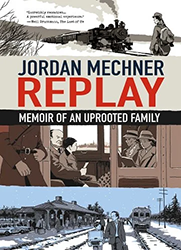Bernice Eisenstein calls her thirst for knowledge about the Holocaust an addiction, similar to being addicted to a drug. As a child growing up in Toronto, she sought information about the Holocaust in books and movies, and learned from observing and listening to her parents, grandparents, aunts and uncles, and their circle of survivor friends. Being a child of Holocaust survivors gave Eisenstein a certain distinction around her friends and allowed her to “socially trade” on the fact that she was different because of her parents’ past. From young childhood (“stop pulling my pigtails because my parents were in Auschwitz”) to adulthood (“I’m not like the other girls you date because my parents…”), the legacy of the Holocaust has always been the elephant in the room with a presence of its own. Throughout her heavily- illustrated memoir, Eisenstein is successful in weaving together her own story with that of her parents and relatives, while always circling back to the Holocaust as the unifying theme in all of their lives.
Part graphic novel, part memoir, Eisenstein’s book is a unique and, at times, humorous look at a sober topic. Her black-andwhite drawings are done in ink with a light gray wash, and they have an almost childlike feel. People are depicted with large heads and expressive eyes, and are shown sometimes in surreal, Chagall-esque settings. There will be comparisons between Eisenstein’s work and the now-classic graphic novel of Holocaust survivors, Maus. Readers need to keep in mind that these are two very different works, despite the common theme, and Eisenstein’s book will stand the test of time on its own merits.




